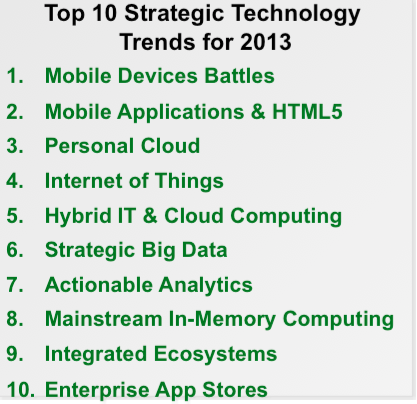 高德纳(Gartner)又有新榜单发布。本周,该公司正在于奥兰多举办的高德纳IT博览会(Gartner Symposium IT Expo)上做东招待1万名IT专业人士。
高德纳(Gartner)又有新榜单发布。本周,该公司正在于奥兰多举办的高德纳IT博览会(Gartner Symposium IT Expo)上做东招待1万名IT专业人士。
周一,该研究公司发布了“未来五年十大关键科技趋势”。
周二,高德纳公司又更近一步,发布了“2013年十大最具战略技术趋势”。
以下是对高德纳公司幻灯片上所列的每个趋势的一些说明:
移动设备战:移动体验蚕食着桌面体验。消费化推动平板电脑进入企业。云和移动两大趋势相互加强。自带移动设备趋势加速。2013年,移动设备将超越个人电脑成为最常见的上网工具。到2015年时,成熟市场中超过80%的手持设备将是智能手机。其中20%将是Windows手机。到2015年,平板电脑出货量将是笔记本电脑出货量的一半,Windows 8将成为苹果(Apple)和安卓(Android)之后的第三大操作系统。微软(Microsoft)占整个客户端平台的份额将下降到60%,并且可能降到50%以下。在智能手机领域,Windows将超越RIM成为第三大品牌,并且到2015年时其销量将与苹果齐平。Windows 8操作系统将“相对利基”,主要吸引企业用户。
移动应用和HTML 5:2014年,JavaScript的性能将推动HTML5及支持HTML5的浏览器成为主流应用开发环境。随着HTML5日益强大,本地化应用将向HTML5进行长期转变。但本地化应用也不会消失,并将一直提供最佳体验。
个人云:云将成为数字生活的中心,用以处理各种应用、内容和偏好。并能在各个设备之间进行同步。服务变得更为重要;设备退居其次。
物联网:物联网早已有之。超过半数的网络连接是通过物品实现的。2011年,网上有超过150亿件物品,间接连接超过500亿次。到2020年时,将有超过300亿件的相关联物品,间接连接超过2,000亿次。涉及的关键技术包括:嵌入式传感器、图像识别以及近场通信(NFC)。到2015年时,超过70%的企业中,只要执行一个命令就将监控所有与互联网相连的东西。物联网变成无所不包的“万联网”。
杂糅IT(Hybrid IT)与云计算:IT的地位发生改变。IT部门必须在协调各种IT相关活动中扮演更多角色。
战略大数据:企业单位需要关注非传统型数据类型以及外部数据来源。分布式文件系统Hadoop和NoSQL数据库发展加快。大数据将遇上社交。网上五个最大的数据源包括:社交、意向、消费、兴趣和移动。“单一的企业数据库”这一概念已死。多个系统需要被绑缚在一起。
可行性分析:在2013、2014年中,云、打包分析、大数据都将加速发展。现在可以对企业所采取的每一步行动进行分析和模拟。移动设备将可以访问数据,从而支持商业决策的制定。
主流内存计算:改变预期、设计和架构。能够提高性能并缩短响应时间。使实时自助服务业务智能化。SAP及其他公司将在今明两年加快相关应用软件的交付以充分利用内存能力。
整合的生态系统:软件和服务将进行更多打包捆绑,用以解决基础设施或应用工作量(application workload)问题。将会出现更多以软件当硬件用的“装置”。新趋势:虚拟装置——高德纳认为在未来五年内其将越来越受欢迎。
企业应用商店:到2014年,应用商店的移动应用程序下载量将超过每年700亿次。另外,大多数企业届时也将通过自己的应用商店向员工提供移动应用。
Another day, another top 10 list from Gartner, which this week is playing host to 10,000 IT pro at the Gartner Symposium IT Expo in Orlando.
Yesterday, the research firm laid out “10 critical tech trends for the next five years.”
Today, Gartner took a look at a little closer in, providing a list of the “Top 10 Strategic Technology Trends for 2013.
You can see the list in the box at right.
Here are a few of their notes on each of the 10 trends, as laid out in the Gartner slides for the presentation:
Mobile device battles: Mobile experiences eclipse the desktop experience. Consumerization drives tablets into the enterprise. Cloud and mobile are mutually reinforcing trends. Bring your own device trend accelerates. In 2013, mobile devices will pass PCs to be most common Web access tools. By 2015, over 80% of handsets in mature markets will be smart phones. 20% of those will be Windows phones. By 2015, tablet shipments will be 50% of laptop shipments, with Windows 8 in third place behind Apple and Android. Microsoft‘s share of overall client platform will fall to 60%, and could drop below 50%. In smartphones, Windows could pass RIM to be #3 player, and could be same size as Apple in units by 2015. Windows 8 will be “relatively niche,” with mostly appealing to enterprise buyers.
Mobile applications & HTML 5: Through 2014, JavaScript performance will push HTML5 and the browser as a mainstream application developer environment. There will be long shift to HTML5 from native apps as HTML5 becomes more capable. But native apps won’t disappear, and will always offer best experiences.
Personal Cloud: Cloud will be center of digital lives, for apps, content and preferences. Sync across devices. Services become more important; devices become less important.
Internet of Things: Internet of things is already here. Over 50% of Internet connections are things. In 2011, over 15 billion things on the Web, with 50 billion+ intermittent connections. By 2020, over 30 billion connected things, with over 200 billion with intermittent connections. Key technologies here include embedded sensors, image recognition and NFC. By 2015, in more than 70% of enterprises, a single exec will oversee all Internet connected things. Becomes the Internet of Everything.
Hybrid IT and Cloud Computing: Changes role of IT. IT departments must play more roles in coordinating IT related activities.
Strategic Big Data: Organizations need to focus on non-traditional data types and externa data sources. Hadoop and NoSQL gain momentum. Big data will meet social. Five richest big data sources on the Web include social graph, intent graph, consumption graph, interest graph and mobile graph. Concept of single corporate data warehouse is dead. Multiple systems need to be tied together.
Actionable Analytics: Cloud, packaged analytics and big data accelerates in 2013, 2014. Can now perform analytics and simulation on every action taken in business. Mobile devices will have access to the data, supporting business decision making.
Mainstream In-Memory Computing: Changes expectations, designs and architectures. Can boost performance and response times. Enables real-time self service business intelligence. SAP and others will accelerate delivery of applications in 2012/2013 to leverage in memory capability.
Integrated Ecosystems: More packaging of software and services to address infrastructure or application workload. There will be more shipment of “appliances,” with software delivered as hardware. New trend: virtual appliances, which Gartner sees gaining in popularity over the next five years.
Enterprise App Stores: By 2014, there will be more than 70 billion mobile app downloads from app stores every year. Also by 2014, most organizations will deliver mobile apps to workers via private application stores.
 高德纳(Gartner)又有新榜单发布。本周,该公司正在于奥兰多举办的高德纳IT博览会(Gartner Symposium IT Expo)上做东招待1万名IT专业人士。
高德纳(Gartner)又有新榜单发布。本周,该公司正在于奥兰多举办的高德纳IT博览会(Gartner Symposium IT Expo)上做东招待1万名IT专业人士。
